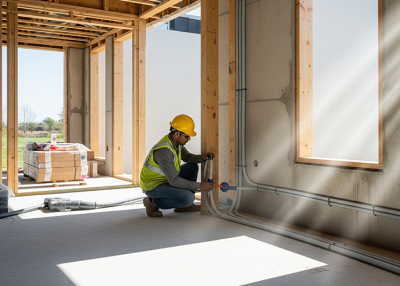A central vacuum system is a built-in cleaning system. Pipes run inside your walls and connect wall inlets in each room to a powerful unit placed in a utility area (store, basement, or service room). You plug a lightweight hose into any inlet and clean—no dragging machines, no cords, far less noise in living spaces.
How a Central Vacuum System Works
- Inlets: Small, discreet sockets on the wall or skirting in main rooms and passages.
- PVC piping network: Concealed lines carry dust to the central unit.
- Central unit: A high-suction motor and large dirt canister placed away from living areas.
- Exhaust: Fine particles are vented outdoors (or filtered before exhaust), helping keep indoor air fresher.
Key Benefits for Indian Homes
- Everyday convenience: Carry only a hose + tool. Clean under sofas, beds, corners—fast.
- Quieter cleaning: The motor is away from the room you’re cleaning.
- Better indoor air quality: Dust and fine particles are removed from rooms instead of blowing back from small onboard filters.
- More power, less effort: Central units are typically stronger than portable vacuums, helping pick up sand, fine dust, and pet hair common in Indian cities.
- Low visual clutter: Nothing sits out on the floor; inlets blend with interiors.
- Long service life: Central units are built for years of use; you upgrade accessories as you like.
Ideal Time to Install (Under Construction or Renovation)
Installation is easiest during construction or a major renovation, when walls/flooring are open to route pipes. Retrofitting in a finished home is possible in some layouts but can be more invasive. If you’re building now, planning the pipe routes with your architect saves time and cost later.
What About Apartments?
Apartments can also use central vacuum lines—typically stacked shafts and passages allow routing—but feasibility depends on layout and association approvals. Many homeowners prefer a compact central unit in a utility balcony or service area.
Typical Costs & Maintenance (Indicative)
- Cost drivers: Built-up area, number of inlets, pipe length, and central unit capacity.
- Maintenance: Empty the dirt canister periodically, wash/replace filters as recommended, and do a quick annual check of inlets and seals. There are no dust bags to buy monthly.
Is a Central Vacuum Right for You?
Choose it if you want:
- fast, everyday cleaning without lifting a machine,
- less noise in living spaces,
- a premium, low-clutter home, and
- you’re building or renovating now.
Next Steps
Send your floor plan and note whether your home is under construction/renovation. Our team will share a layout plan, inlet map, and a transparent quote.
FAQ (rich-result friendly)
Q1: How many inlets will my home need?
A: Typically each inlet covers ~60–80 sq m depending on layout. We place inlets so a standard hose reaches all corners.
Q2: Where does the dust go?
A: Into a sealed canister at the central unit; fine particles are filtered and/or vented outdoors.
Q3: Will inlets spoil my interiors?
A: Inlets are compact and colour-matched; most clients find them subtler than standard power sockets.
Q4: Can I use different tools (sofa, crevice, floor)?
A: Yes—there are attachments for hard floors, rugs, upholstery, shelves, and car cleaning.

